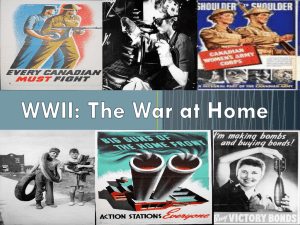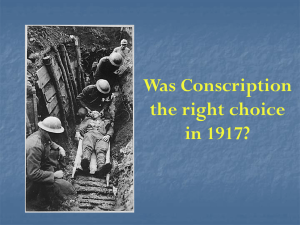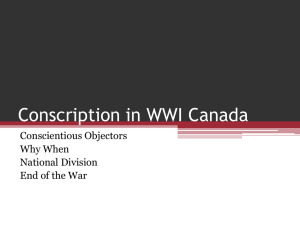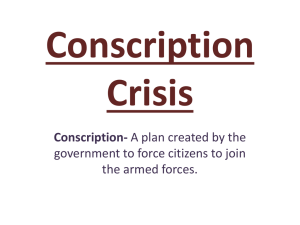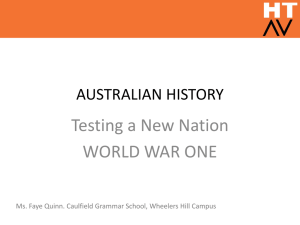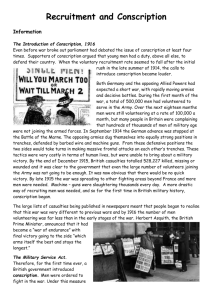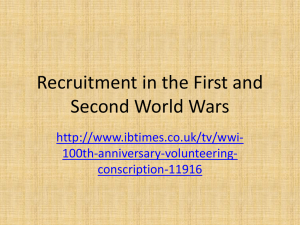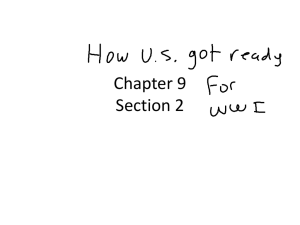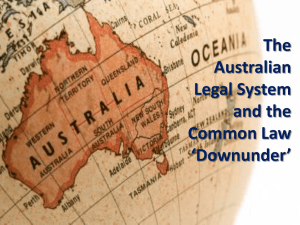Conscription & The Role of Women
advertisement
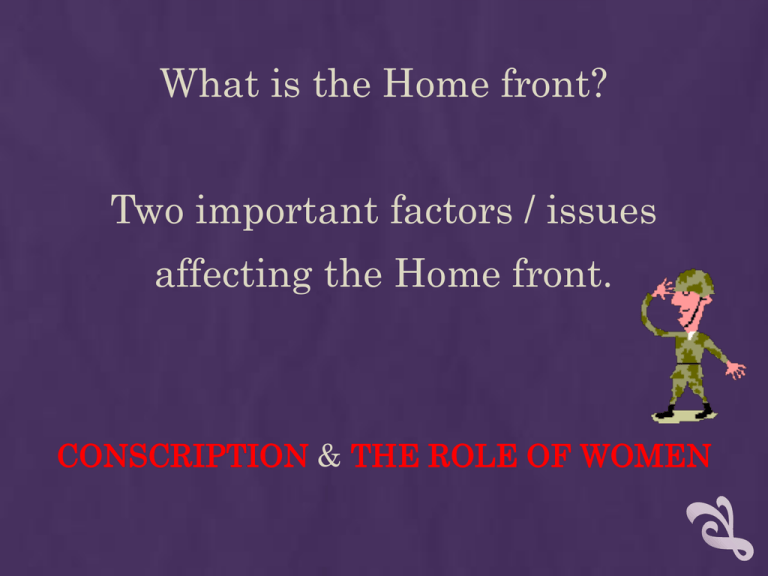
What is the Home front? Two important factors / issues affecting the Home front. CONSCRIPTION & THE ROLE OF WOMEN CONSCRIPTION World War 1 WHAT IS CONSCRIPTION? Conscription is the compulsory enrolment of persons for military or naval service; it is also known as ‘The Draft’. CONSCRIPTION Conscription stirred Nationalist ideas about loyalty to Australia. It made people question what it meant to be an Australian WHY DID WE NEED CONSCRIPTION? 1914 World War 1 Begins There is a rush of Australian men keen to enlist Reasons • Glory / Adventure • See the World / Travel • Money • Ladies • Fear of German invasion • Patriotism • To support Britain End of 1915 The campaign in Gallipoli has been fought and approximately 8,000 Australian men have been killed with no goal achieved. 1916 Australian enlistment figures drop, the Glory of war has been shattered and men are no longer as eager to fight Source – Audio-visual Education centre, Education Department of Victoria, Recruitment Slide set. CONSCRIPTION IN AUSTRALIA In 1916 Prime Minister Hughes proposed raising the numbers needed to maintain Australian troops at full strength at the Front by conscripting those who to date were unwilling or opposed to enlisting to fight. The government already had the power under the existing provisions of the Defence Act to conscript men - but only for service in Australia. They could not be sent overseas to fight. All the government needed to do was to change the Defence Act to extend the existing power of conscription from home service, to overseas service. CONSCRIPTION IN AUSTRALIA All it had to do to achieve that change in legislation was to pass an amendment through both houses of parliament -- the Senate, and the House of Representatives. But there was a problem -- Some members of the Labor Government were against conscription. Hughes knew that he had enough supporters of conscription among the Labor and Liberal parties to have a majority in the House of Representatives; but he was a few short of a majority in the Senate. CONSCRIPTION IN AUSTRALIA To overcome this problem Hughes decided to hold a national vote on the issue. This vote is sometimes called a referendum. Strictly speaking a referendum is a vote to change the Constitution. There was no need to change the Constitution in this case, as the Constitution already gave the government power to introduce conscription. The vote was in effect a national ‘public opinion poll’ on the issue. The vote would not mean anything officially -- but Hughes planned to use the public vote in favour of conscription to persuade a few Senators to change their vote in parliament. CONSCRIPTION IN AUSTRALIA Even though the Senators were personally against it, the vote would show that the people they represented in fact wanted conscription, so the Senators would accept the people’s wishes. That was the idea. The supporters and opponents of conscription started campaigning vigorously on the issue. The campaign literature of each side was often bitter and divisive. Each side presented its argument as the moral and loyal thing to do, while the other’s approach would be disastrous. with conscription being rejected 51 to 49 per cent. The vote was very close -- 1916 Referendum State / Territory Yes No Informal New South Wales 356 802 474 523 27 038 Victoria 353 930 328 216 14 538 Queensland 144 017 157 049 7 596 South Australia 87 908 119 119 4 009 Western Australia 94 049 40875 5 680 Tasmania 48 490 37 830 1 037 Territories 2 136 1 269 63 1 087 332 1 158 881 59 961 Commonwealth Yes No Majority for No 1 087 332 1 158 881 71 549 HUGHES FAILS The failed vote in 1916 was repeated by Hughes in 1917, to give people another chance to overcome what he saw as their great mistake in rejecting it in 1916. Once again it was a close vote and the result was the same – Australia said NO PROPAGANDA FOR A YES VOTE Propaganda for a NO Vote THE ROLE OF WOMEN World War 1 THE ROLE OF WOMEN At the outbreak of war far fewer women than men participated in work, and these tended to be in lowerpaid occupations. Women’s main role was seen to be in the home. The withdrawal of about half a million men most of whom had been in the workforce did not, however, result in their direct replacement by women. Women’s contribution to the workforce: 24 per cent of the total in 1914 37 per cent of the total in 1918 THE ROLE OF WOMEN The increase tended to be in what were already traditional areas of women’s work -- in the clothing and footwear, food & printing sectors. There was some increase also in the clerical, shop assistant and teaching areas. Unions were unwilling to let women join the workforce in greater numbers in traditional male areas as they feared that this would lower wages. THE ROLE OF WOMEN Many women sought to become more involved in war- related activities -- such as cooks, stretcher bearers, motor car drivers, interpreters, munitions workers -- but the government did not allow this participation. A number of women’s organisations did become very active during the war -- including the Australian Women’s National League, the Australian Red Cross, the Country Women’s Association, the Voluntary Aid Detachment, Women’s Christian Temperance Union, the Australian Women’s Service Corps, and the Women’s Peace Army. THE ROLE OF WOMEN Many women were also actively involved in encouraging men to enlist, and were often used in recruiting and pro-conscription and anti-conscription propaganda leaflets. HOME FRONT: DEBATES The class will be divided up into four groups and each group will be given an issue and argument to develop. Based on the information we have just gone through and the resources provided to your group read through and discuss the evidence to support your argument. You are to select three members of your group to represent you in the debate, they are to take on the roles assigned to them and argue your case as best they can. Those of you who are not debating remember to show your support for your group as they perform the debate. THE 4 ARGUMENTS The Role of Women The Issue: The role of women in WWI and the impact this had on their role in Australian society. You are: A group of feminist historians reflecting on the issue. Your task: To use the information provided to develop a strong, convincing argument that Although women contributed to Australia’s WWI war effort, it had no effect on their social status in Australian society. The Issue: The role of women in WWI and the impact this had on their role in Australian society. You are: A group of feminist historians reflecting on the issue. Your task: To use the information provided to develop a strong, convincing argument that women played a vital role in WWI and that this changed their social status in Australia. THE 4 ARGUMENTS Conscription The Issue: The 1916 referendum to decide whether conscription (compulsory military service) will be introduced in Australia. You are: Archbishop Daniel Mannix and members of the Queen’s and Women’s Peace Army. Your task: To use the information provided to develop a strong, convincing argument that conscription is not necessary in Australia to aid Australia’s WWI effort. The Issue: The 1916 referendum to decide whether conscription (compulsory military service) will be introduced in Australia. You are: Prime Minister Billy Hughes and members of the Labor party supporting the ‘YES’ vote. Your task: To use the information provided to develop a strong, convincing argument that conscription is necessary in Australia to aid Australia’s WWI effort.

